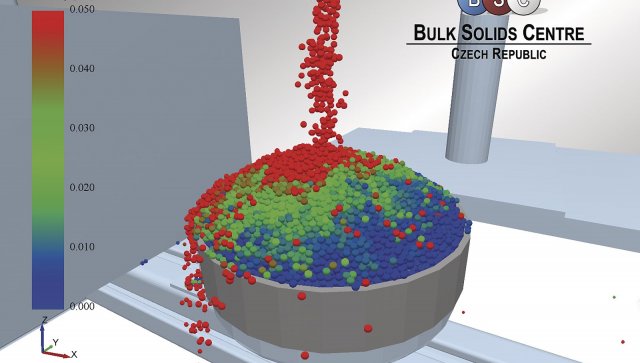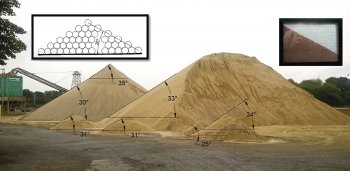Published: 8 November 2017
Bulk matter is an integral part of everyday life. We meet it at every step, manipulate it, store it, pack it, sort it and even consume it. In order to carry out all the listed operations with this substance, it is necessary to know its mechanical-physical parameters. Based on them, we are able to design transport, treatment or storage processes and equipment. When mining mineral resources, we usually store bulk in the open air in the first phase of mining, and we need one of the basic data of the extracted bulk mass, its bulk angle.

From this parameter, the amount of material and bulk weight, we simply find out by basic mathematics how much area we will need for storing bulk material. In the laboratory of the Bulk Mass Center, a team of experts is engaged in measuring the bulk angle, because measuring this angle correctly is not as simple as it might seem at first glance. It is clear that each pile forms an angle to the pad and we can easily measure it with a promensometer.
ZENEGERO measuring and validation machine
If we dig deeper into the problem, we find that with the same bulk material, we can always measure a different bulk angle of the pile. This is due, for example, to different material humidity, or to different ways of creating a heap and other parameters that enter the plot of mass formation. Since these conditions may change over the course, it is good to know the processes and laws by which bulk matter is governed. In the laboratory of the Centre of Bulk Masses of the Czech Republic, a ZENEGERO measuring and validation machine was designed for this purpose, which was patented. On this machine it is possible to determine the bulk angle both static and dynamic, and in conjunction with simulation methods it is possible to further examine the principles of arrangement and flow of bulk mass and to determine the causes affecting the formation of piles under various conditions, for example, weather conditions. Furthermore, according to the measured real bulk angle, it is possible to define the material in the DEM method simulation and test this particular material in various applications and processes.

Theoretical plane of mass formation
If we transfer to the theoretical plane of mass formation, we will come across a well-known definition of ideal bulk matter and its geometric interpretation in literature. The word ideal suggests that it is good to search in practice or approach the theoretical ideal state of bulk matter so that the devices work without any problem. Professor Zegzulka defined this mathematical model of the ideal bulk mass and found that the angle of slope of this mass is invariant and always 30°. He also defined 10 basic mechanisms, i.e. ways in which individual particles change their position vis-à-vis the surrounding particles. This defines how particles can move and, as a result of „teuing“ in reservoirs, containers, but also when mixing, crushing, sorting, etc.
Practical experiments and simulation calculations
These findings, combined with practical experiments and simulation calculations, give the design of equipment and processes a new dimension. This innovation is in understanding the behavior of bulk matter, which increases the likelihood of the functionality of a newly designed or optimized device. It also allows you to find completely new solutions that are important for further development of technology, for example in Industry 4.0 in the field of 3D printing. More and more people are realizing that the representation of bulk masses is not only dominant on earth. Since, according to the discovery of Professor Zegzulka, bulk matter is a new state, we can look forward to further great development of this field in the future, improvement of measuring technique for measuring mechanical -physical properties of bulk masses, and we may even see that the measurement of the bulk angle and the new state of „bulk matter“ will be taught to children already in elementary schools.
Author: Daniel Gelnar, Ph.D.
Photo: Author’s Archive
Translate from czech: Google